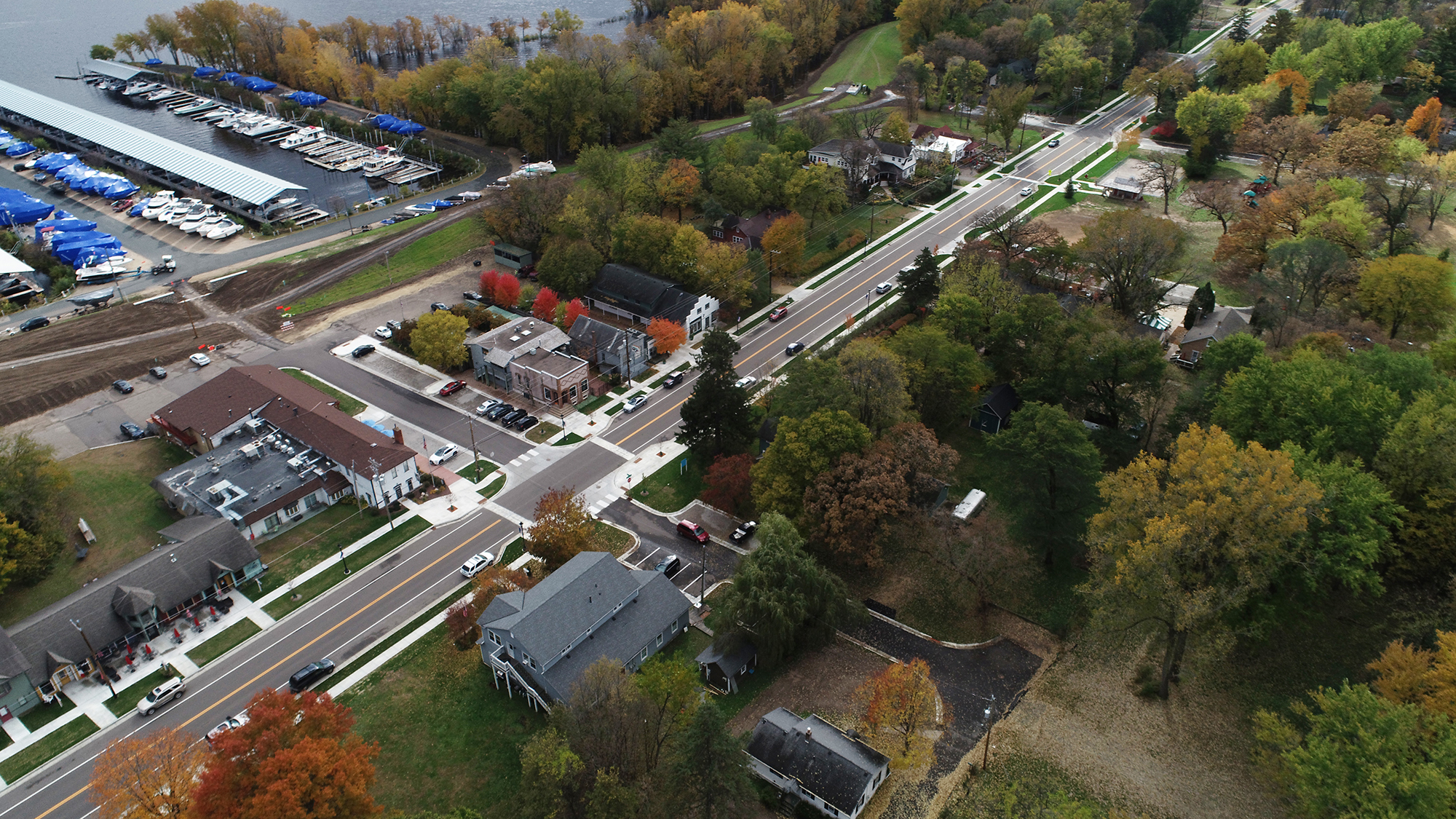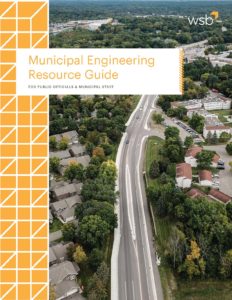


Newsletter | Issue 1 | 2019

Downtown Afton Revitalization awarded 2019 Project of the Year
WSB was recently selected as a 2019 Small Cities/Rural Communities Projects of the Year recipient for the Downtown Afton Revitalization by the American Public Works Association’s (APWA). The revitalization project was featured in the Historical Restoration/Preservation award category. The award recognizes excellence in project management, administration, and coordination of public works projects. Winners are selected based on six project categories.
The APWA is a nonprofit organization that provides support to public works personnel through educational and networking opportunities. The Public Works Project of the Year winners will be recognized at the 2019 APWA Public Works Expo in September.
See the complete list of winners in this month’s issue of the APWA Reporter.

A hole-in-one solution
Creating a sustainable water reuse system for the Rochester Golf & Country Club
By Bob Barth, Director of Land Development, WSB
For over 100 years, the Rochester Golf & Country Club has been a fixture in its community. Since opening, land around the course developed, but the rolling greens of the Country Club still attract golfers as they did in the early 1900s when a group of avid golfers leased 100 acres from two Mayo Clinic doctors.
The Decorah Shale effect
The landscape 100 years ago was very different than it is today. As development occurred throughout the area, the course began to experience water issues. The course is located on the Decorah Shale Geologic Formation, an over 60-foot-thick layer of shale bedrock. Water passes through the impermeable shale layer slowly, causing drainage issues for many properties throughout southeastern Minnesota. In the case of the golf course, water is unable to penetrate the shallow shale layer located below the surface of the course, creating drainage issues and pockets of standing water on fairways and greens.
The most inexperienced golfer knows that standing water on a golf course leads to playability issues. At one point, there were playability issues on seven of the 18 holes – equating to 3,000 feet of playing conditions that had standing water or drainage problems. The County Club reached out to our team at WSB to find a sustainable solution to the chronic water issues that plagued the historic course.
Keeping greens, green
Golf courses use a lot of water and droughts or excess water negatively impact course profitability and sustainability. Like many Minnesota courses, Rochester Golf & Country Club uses groundwater for irrigation. However, the playability issues caused by the Decorah Shale are unique. Research and studies have criticized golf courses over the years for chemical and water use, particularly groundwater. Recently, many courses have taken strides to become more environmentally sensitive and eco-friendly. Rochester Golf & Country Club approached their golf course renovation project with sustainability in mind and decided to reuse the seepage water and surface water as a partial replacement for the groundwater they used for irrigation. This process allowed them to improve their environmental footprint.
Creating a solution out of the problem
WSB performed a rigorous rainfall and runoff analysis to determine the amount of available seepage and runoff water. The analysis included long-duration simulations of water yield and irrigation using state-of-the-art hydraulic modeling software. Every water reuse project is unique. Most of the land that Rochester Golf & Country Club sits on drains in a single direction, making it easier to capture seepage and runoff water. This efficiency of drainage created a single point of collection into a new irrigation pond.
After completing the reuse analysis, we worked with the Country Club and an irrigation design consultant to design the irrigation pond, pump station and pump house, the collection system to deliver water to the irrigation pond, and the outlet works from the pond to the public system. Drainage tile was placed under the fairway turf to allow water to feed into the irrigation pond. In the past, the Country Club used over 10 million gallons of groundwater for irrigation, annually. With the new water reuse and drainage system, the course’s groundwater usage dropped to 4 million gallons. The water reuse system can pump as much as 1,500 gallons per minute into the irrigation system. The reuse system also alleviates the need to tap into the city’s water supply and ensures that the course can stay watered even when conservation restrictions are in place.
Full-circle sustainability
The Rochester Golf & Country Club is dedicated to sustainability beyond water reuse and has established an on-site, 10,000-square-foot garden that supplies fresh produce to their executive chef. Additionally, the club is home to 400,000 honey bees, an effort to protect the honey bees’ declining population. Throughout the Country Club’s recent restoration, they have paid close attention to reusing available resources including creating benches out of downed trees and repurposing old cart path rock for new cart path base layers.
A fresh start in 2019
The course has been under construction since 2016 and reopened this spring. Under the direction of renowned golf course architect Tom Doak, the acclaimed 18-hole golf course went through a substantial renovation to restore the course to its original 1925 A.W. Tillinghast design.
Golf is a significant economic driver in Minnesota and water plays a vital role in keeping these courses busy throughout the golf season. In addition to our work on the Rochester Golf and Country Club, WSB has developed water reuse systems and measures for Oneka Ridge Golf Course in Hugo and Eagle Valley Golf Course in Woodbury.
B ob is a Principal at WSB with over 20-years of experience providing technical and management support to public and private clients. Bob’s special expertise in water resources management, infrastructure planning, project development, and land development make him an effective and trusted adviser on a variety of projects.
ob is a Principal at WSB with over 20-years of experience providing technical and management support to public and private clients. Bob’s special expertise in water resources management, infrastructure planning, project development, and land development make him an effective and trusted adviser on a variety of projects.

WSB announces vice president promotions
July 1, 2019
Environmental services, corporate development and technology divisions get new leadership
Minneapolis, Minn. – Local engineering firm WSB today announced the promotions of Andi Moffatt, Brian Bourassa and John Mackiewicz to vice president positions in the environmental services, corporate development and technology divisions, respectively. In their new roles, Moffatt, Bourassa and Mackiewicz will be responsible for their divisions’ revenue targets and new business goals; growing markets and service areas; and improving the use of technology solutions – all while focusing on attracting and retaining talented staff.
“I am incredibly excited about the expanded roles and responsibilities that all three of these leaders are taking on at WSB,” said Bret Weiss, WSB president and CEO. “Andi, Brian and John have made impressive impacts to our firm’s success, and I am thrilled that they will continue to help drive our results as we grow our business.”
The promotions come on the heels of significant growth at WSB, as well as the expansion of the executive team with the creation of chief financial officer and chief operating officer positions. As the fourth-largest engineering firm in the Twin Cities, WSB has 12 offices in four states, with its newest office opening recently in Austin, Texas.
To view the resumes and headshots of the three new vice presidents, click on the links below:
- Andi Moffatt, Vice President of Environmental Services
- Brian Bourassa, Vice President of Corporate Development
- John Mackiewicz, Vice President of Technology
Tips for maneuvering 4th of July construction
Drive safe
Between the increased number of travelers and the numerous road construction projects underway this summer, the Fourth of July is one of the most dangerous times to be on the roads in Minnesota. This year, there will be 70 different construction projects happening over the holiday, several of which are occurring on major highways from I-35W to I-94.
As a Director of Safety and Risk Management at WSB, it’s my job to ensure that we’re doing everything we can to keep drivers, their passengers and road crews safe when moving through a zone where our surveyors and engineers are working, from signage and lights to proper barricading. But there’s plenty you can do too, to ensure the safety of your family and those around you as you hit the road for the holiday.
Follow these tips
Make sure your vehicle can go the distance.
Swimsuit? Check. Sunscreen? Double check. You may have nailed your packing list, but your vehicle needs just as much attention. Make sure your tire pressure and tread are up to par, and that your spare tire is looking good too. And don’t forget to keep a break-down/emergency kit handy as well! This includes a jack and tools for any flats or blow outs that may occur.
Plan ahead.
Knowing whether there is road construction on your route is important. The Minnesota Department of Transportation (MnDOT) posts all construction projects on its website, and most map applications should be up to date with the latest detours and lane closures.
Stay alert.
Don’t count on coffee to keep you vigilant while driving. You may be itching to get to your destination, but make sure you take regular breaks and get at least eight hours of sleep before hitting the road.
Adjust your speed.
Speed is the number one cause of accidents and fatalities in construction zones. Move over for parked emergency or maintenance vehicles, and slow down to 20-miles-per-hour when passing.
Practice defensive driving.
It may take a bit of a driver’s ed refresh, but defensive driving is key. Accidents in construction zones are often a result of drivers having little or no reaction time, leading to rear-end collisions. Avoid distractions, cell phones or passengers who are taking your attention from the roadway. Allow plenty of stopping distance between your vehicle and the vehicle in front of you, a minimum of two car lengths.
Do NOT drive impaired.
It seems obvious but driving while under the influence is a leading cause of death in construction zones, second only to speed. If you choose to indulge on your holiday travels, be sure to have a designated driver.
As we all look forward to the fun this holiday will bring, keep these tips in mind. This simple list could be the difference between getting to the fun safely, and not getting there at all.
 Jason Daugherty is the Director of Safety and Risk Management on our construction team with over 20 years of experience performing safety management in construction, pipeline, aviation, DOT, environmental, and incident and accident investigation.
Jason Daugherty is the Director of Safety and Risk Management on our construction team with over 20 years of experience performing safety management in construction, pipeline, aviation, DOT, environmental, and incident and accident investigation.

